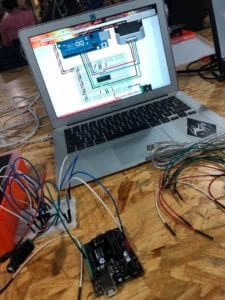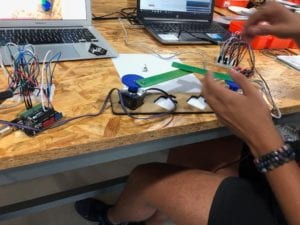This recitation was a little more tedious to execute. The goal, again with my partner Ruben, was to create a machine (using stepper motors) that could draw, while being controlled by potentiometers.
The first step was to complete the circuit, since it was a lot of wires it was a little taxing, but not too hard (it really was just a lot of wires). The stepper motor was simple to connect, since it comes with a set of colored wires indicating what needs to go where; the tougher part was connecting the potentiometer to it and making sure it controlled its movements. However, it was not too difficult.

After completing the circuit, the next step was to connect Rubens’ and my circuits to what can only be describe as stepper motor holders, and attach the pincers that would hold the pens!

Video of stepper motor and code:
In the end it was quite fun to be able to make a machine that controlled the movement of the pens, even though we were the ones controlling the machines!
Question 1:
When thinking about what type of machine I would like to make using actuators that manipulate art, my first thought was about the massive 3D printers that are being worked on to be able to print whole cities: http://theconversation.com/print-your-city-3d-printing-is-revolutionizing-urban-futures-112365 . However, this does not seem too appropriate considering the actuator is a machine itself, and less controlled by humans. A simpler, and maybe unusual example that I came up with, was to use the same stepper motors to control puppets. All over the world puppets are used in theater, especially string puppets. I think it would be interesting to connect them to these types of motors (however, the number would be much higher than just two!). Maybe then the dynamic would change in the scenes, and maybe the movements would be more fluid.
Question 2:
I quite enjoy the Mechanical Mirrors: Wooden Mirrors project by Daniel Rozin. It seems to me that sensors are the actuators, that lead to the spinning of some type of motor, to change the side of the wood (hence change its color to a darker shade for contrast). It is interesting, in comparison to the recitation exercise, that the actuator is another machine that reads the human, however in a very different way than the potentiometer. The sensor in the art exhibit discovers the values on its own, the potentiometer for the drawing machines uses the values that we force upon it.